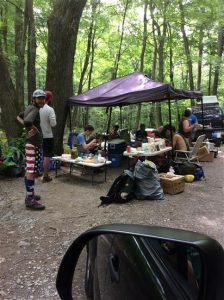Title: Down the Line Fist Bump
General Information about Item:
- Genre: Customary
- Subgenre: Ritual, Tradition
- Language: English
- Country of origin: USA
Informant Data: Will Kaufman ’20 is a 19-year-old male caucasian light-weight rower from Boulder, CO. He is the middle child between two sisters. He started rowing his freshman fall upon entering Dartmouth. As a walk-on rower, he came in knowing nothing about the sport.
Contextual Data:
Social Context: Like most, race-day rituals, this Down the Line Fist Bump is primarily taught inside the boats. The rowers line up before readying up for the race, and before they begin competing, they send a fist bump from the stern to the bow (front to back), in order to motivate each rower and encourage them.
Cultural Context: Like most of the folklore of the D150 Team, this piece focuses on fostering team unity and bolstering motivation. It unites both new and experienced rowers who are in the same boat with the same sending of the fist bump continuously from front to back. In addition, it encourages newer rowers like Will, who may be nervous about their early competitions.
Item: This item is a customary piece of folklore that helps build team unity and motivates/encourages the rowers to try their best. It is customary because it is a single practiced ritual that happens every race in the same way that involves the same people in every boat. It is folklore because it is performed by all the members of this folkgroup in their respective boats and celebrates their commonalities (in this case, them being in the same boat).
Associated media:
Transcript (4:04 – 5:15):
WK: “When we’re all lined up ready to go, we typically just, like, start from stern to bow, um just send back a fist bump. So, uh, like, I don’t know, stroke will be uh just, turn around and fist bump seventh seat, and seventh seat fist bumps sixth seat and just send it down to bow. Just to kinda get everyone hyped up and ready to go… and uh I don’t know, just ‘hey, we’re all in this together, let’s go row.'”
BC: “So for something like that, right, like, when you first kinda encountered that, what was that like? Did you just kinda, sit down and did someone tell you, ‘hey, we’re gonna do this,’ or did you just know to do it instinctually?”
WK: “Uh… I mean, I knew to receive the fist bump instinctually, but uh… I forget who it was, probably… who was it…. it might have been Jason Auh, who was a ’17, or someone else. But, like I, uh, took the fist bump and was like, ‘Oh yeah, cool, ready to go,” but then he told me to send it back, and that kinda clicked in my head, ‘Oh, hey it’s a whole boat thing.’ So it’s just like everyone is like getting together and like focusing before the race starts.”
BC: “Right, right.”
WK: “So after the first time, it was pretty clear. Okay, fist bump forward, fist bump back.”
Collector’s Comments:
- Sending “The Fist Bump” is interesting to study because it as simple as it seems, it still provides motivation for each of the rowers, both inexperienced and experienced. This unifying gesture shows the usages/importance of folklore to folk groups, especially when it comes to differentiation of their groups v. others.
Collector’s Name: Brian Chekal

